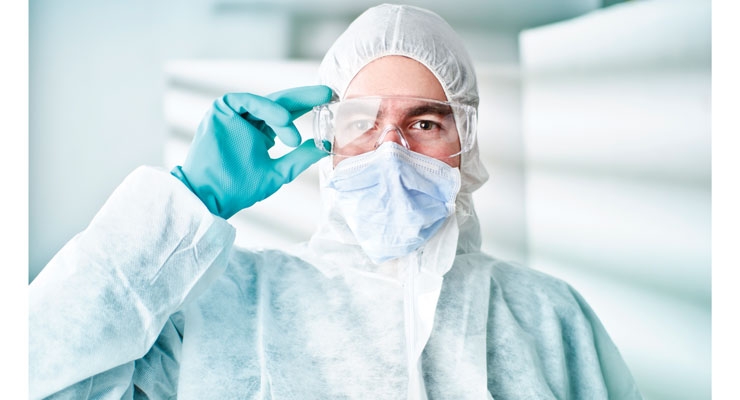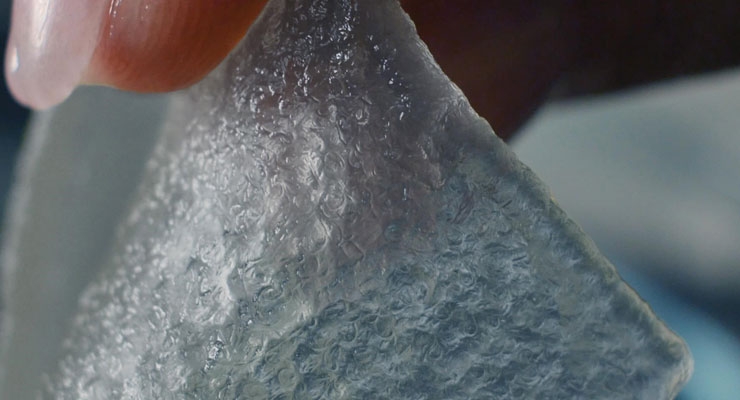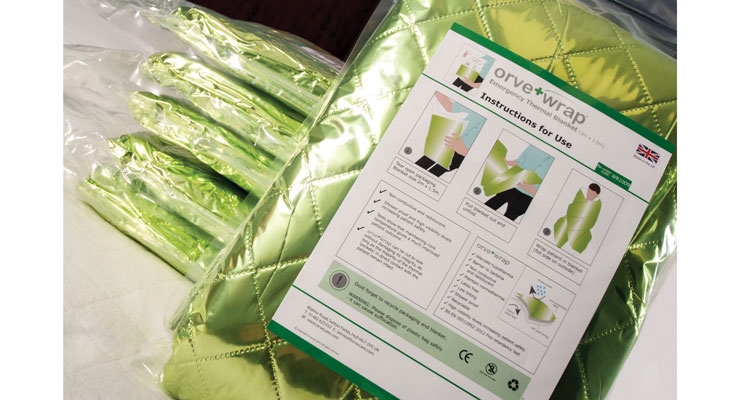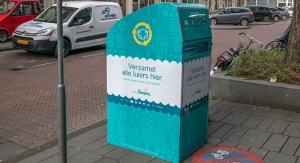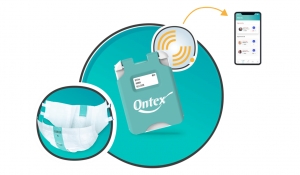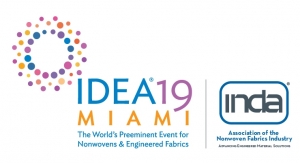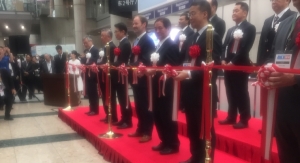Tara Olivo, Associate Editor08.09.18
The total consumption of nonwovens in medical applications is expected to reach 351,000 tons by the end of this year, up from 264,000 in 2012, according to research firm Smithers Pira. Consumption is expected to rise to 427,000 tons in 2023. The value of this market in 2018 is $1.33 billion, rising to $1.54 billion in 2022.
Surgical drapes and gowns, wound dressings, underpads, head and shoe covers, CSR wrap, face masks, blood filters, implantables, and even sutures and sponges can all be made with medical nonwovens. According to Smithers Pira’s report, The Future of Global Nonwovens to 2022, the largest single use for disposable nonwovens in the medical market is surgical drapes and gowns; but as the fear of infectious diseases continue to grow worldwide, other applications, like face masks, are expected to grow rapidly. Medical nonwovens for would care applications are also expected to experience growth in the future.
The prevalence of healthcare-associated infections (HAIs) is also driving growth for medical nonwovens. According to the Centers for Disease Control and Prevention, roughly one in 25 hospital patients has at least one healthcare-associated infection on a given day. In fact, HAIs can significantly delay recovery, increase the cost of a hospital stay, can result in death in some cases, while also costing healthcare institutions billions of dollars annually.
The global surgical gowns market is growing at a considerable rate due to the rising number of high-risk surgeries and technological advancements in the medical field. Ahlstrom-Munksjö anticipates the use of nonwovens to continue to grow to assist with infection control, patient and healthcare staff protection, according to Jason Beard, Platform Leader - High Performance Medical.
“In emerging markets we often hear that doctors who are trained abroad and educated on the benefits of single-use solutions are also helping to drive growth. When they go back home, you see adoption of these solutions that may not have been used previously,” he says.
Jacob Holm has seen increasing pressure to reduce and ultimately eliminate hospital infections, but has also noted that governments have increased their involvement in health care budget reduction. “Our health care innovation efforts have shifted to address these needs,” says Martin Mikkelsen, Jacob Holm Group CEO.
From a regional point of view, Jacob Holm anticipates major growth in South and Latin America due to changing regulations and the low penetration rate of disposable material. “We have seen an increased demand for the replacement of reusable gowns, drapes, masks and other materials in the OR,” Mikkelsen points out.
Globally, advanced wound care is also seeing significant growth due to increasing prevalence of surgical wounds and ulcers, an aging global population, and increased demand for evidence-based advanced wound care products and extended wear materials suitable for monitoring devices, he adds.
In the medical market, Jacob Holm’s Sontara spunlace is made without the use of binders or chemicals and is friendly to sensitive skin. Sontara is being used for gowns, drapes, patient and staff apparel, wound dressing, tapes and bandages including extended wear, compression devices, orthopedics, patches and towels.
“The strength of our nonwoven fabric from the proprietary production process makes it resistant to wear and tear which is critical in delicate situations,” says Mikkelsen. “The low linting, softness, breathability and drapeability of our medical fabrics provide maximum comfort and peace of mind for the patient and physicians in longer-lasting critical procedures.”
Most recently, Jacob Holm added 100% sustainable fabric for medical apparel to its product portfolio. These product options are produced with fibers made with 100% renewable resources.
“Sustainability is important at Jacob Holm, and we are working diligently to provide eco-friendly products to all of our segment portfolios,” Mikkelsen says.
Also new from Jacob Holm is a stretch fabric for wound care applications. Sontara nonwoven stretch products are breathable, soft and extensible. The company offers varying degrees of stretch and recovery as well as a variety of nonwovens blends and gauges.
For its part, Finnish nonwovens producer Suominen is witnessing strong growth in Latin America where it recently invested at its plant in Paulínia, Brazil. “The investment has enabled us to supply medical products from the plant as well,” says Marika Mäkilä, product manager, Medical at Suominen. “We are seeing there replacement of traditional textiles but also totally new application areas.”
Suominen’s Fibrella product family has launched in the South American markets in recent years, including Fibrella Wrap, a new material for undercast paddings and cushions used in wound care.
Other unique products under the Fibrella portfolio include Fibrella Zorb+, which is designed for surgical drapes and provides rapid absorbency around drape fenestration and reduces post-operative clean-up time. Meanwhile, the Fibrella Perf product family is developed for wound care products where its softness, skin-friendliness and absorbency are valued.
When it comes to the benefits of single-use nonwoven-based medical products compared to reusables in the medical space, Mäkilä says it is important to pay attention first to the specific purpose of the material. The primary purpose of a nonwoven for gowns and drapes is to create a barrier between a patient and the healthcare professional, preventing bacteria and viruses from spreading, keeping them both safe, she says. In wound care, the liquid management features are the key as the material has to be absorbent, anti-bacterial, and liquid repellent – and soft, she adds.
“If we compare single-use nonwovens with traditional reusable materials in gowns and drapes, we will see that the benefits of nonwovens are clear,” Mäkilä explains. “Even though the reusable materials have evolved, studies still favor disposable gowns and drapes as having a more solid, reliable and reproducible bacterial impermeability. With reusable gowns, these properties seem to fade with wetting or repeated wash. Moreover, the single-use materials are easy-to-use, safe to dispose and also economical solution.”
Even within nonwovens itself, the functionality and features of medical nonwovens vary remarkably from one technology to another. “In drapes, our Fibrella Zorb+ material is used in drape fenestration areas thanks to its excellent properties: its absorption capacity is twice as fast as competitor’s products made of spunbond. This way it reduces post-operative clean-up time. It is also easily drapable and conformable, which is a great benefit for example when compared to airlaids.”
For decades, Ahlstrom-Munksjö has been making high performance medical fabrics that are used in sterile barrier systems, drapes, gowns and facemasks. Its product folio consists of single-use fabrics that are used in the operating room, cleanroom and sensitive environments. Its breathable viral barrier (BVB) fabrics have an innovative tri-laminate technology that provides breathable impervious protection guarding patients and health care staff against viruses, bacteria and fluids.
One of Ahlstrom-Munksjö’s newer fabrics, PureArmor, is a next generation tri-laminate nonwoven that has extremely low lint, making it suitable for environments that are sensitive to particle contamination. The proprietary manufacturing process welds bicomponent spunbond fibers together, which makes the fabric less prone to shedding without sacrificing softness.
The barrier film layer at the center of the tri-laminate fabric is a membrane, which has a nonporous monolithic structure that provides an impervious barrier, thus blocking the passage of viruses, bacteria, fluids and particles. The structure of the film lets moisture vapor to pass through, allowing the wearer to remain comfortable while providing the highest level of protection.
“PureArmor is an evolution leveraging the insights we learned making high performance fabrics used in the operating room. We took that same technology and created a fabric that would be ideal for many applications outside the operating room,” Beard says.
PureArmor works to stop particles from being emitted into the cleanroom—keeping them encapsulated within the apparel made with PureArmor and not emitting them into the cleanroom, he explains. “With it being a film based tri-laminate, particles are prevented from passing through the fabric.”
According to the company, most nonwoven fabrics available for cleanroom applications have particle filtration efficiency between 94-98%, meaning that the fabric allows hundreds of thousands of particles to be released into the cleanroom environment in addition to potential blood borne pathogens. PureArmor’s monolithic film design makes it impervious to particles and potential blood borne pathogens.
“There are other film based fabrics out there that try to do this, but most often they are non-breathable causing them to have comfort issues,” Beard says.
Ahlstrom-Munksjö has been in the breathable viral barrier market for surgical gowns for over 15 years, and in the third quarter of this year, a next generation breathable viral barrier fabric will roll out.
Wound Care Warriors
TWE Group’s know-how in the medical market is in fluid management. From a strong pedigree in hygiene absorbent products, TWE has developed a portfolio of wound care and padding products in close cooperation with leading medical device companies.
A prime category is that of pressure distribution and exudate absorption layers in Negative Pressure Wound Therapy (NPWT) composites, according to Jelle Westerterp, business unit director Hygiene & Healthcare, TWE Group. In this instance, TWE’s nonwovens help maintain constant and even negative pressure and absorb exudates, extending the change intervals of the media as well as aiding the healing process. “At the same time, the NPWT composite structures may be made thinner and more flexible, making them easier to apply as well as improving patient comfort,” Westerterp adds.
Meanwhile, TWE’s Exudate Management System (EMS) market encompasses a wide variety of systems, ranging from sticky plasters to sophisticated advanced wound dressings. TWE nonwovens may be part of a composite structure, which effectively draws exudate away from the wound and retains high amounts of it. “Thus, these laminates provide for reduced dressing frequencies, whilst promoting healing and increasing patient comfort in a cost-effective manner,” Westerterp explains.
With conversion facilities of orthopedic and splint cast padding at dual sites, TWE can provide medical device companies with ready-made end product. With varying compositions of viscose and polyester fibers, the padding material, its labeling and packaging may be tuned to the customers’ desired specification. “All they need to do is integrate the product in to their portfolio and organize the distribution to care takers and clinics, along with the rest of their product range,” Westerterp says.
When it comes to the market for medical nonwovens, TWE is optimistic. “NPWT and advanced EMS composites are growing by 3% to 8% p.a. due to these more sophisticated treatment options helping patients to heal faster and reducing the overall cost of treatment,” Westerterp notes. “Within the overall stable cast padding segment, we observe a shift from traditional plaster towards splint casting. Shorter treatment reduces costs and the application is less messy.”
For Freudenberg Performance Materials, new developments include foams that have a direct coating of silicone adhesives.
These products make it easier to apply the foam dressing to the patient and at the same time achieve a wound adhesive effect. This is made possible by the adhesive properties of silicone.
“Compared to conventional transfer coatings, this patent-pending innovation gives the customer several advantages,” explains Dr. Frank Heislitz, CEO, Freudenberg Performance Materials. “It helps in offering wound dressings that are much more flexible than conventional products and can adapt better to the wound bed. Antibacterial finishes can also be more effective. In addition, by reducing process stages and complexity, energy is saved, waste avoided and the supply chain simplified.”
The company has also begun ISO 13485-compliant series production of laminates comprising hydrophilic PU foams and hydroactive nonwovens in the last year.
Worldwide, Freudenberg is one of the few suppliers of materials for modern wound care to manufacture both laminate components – PU foams and hydroactive nonwovens. According to the company, this opens up the possibility of optimally matching the two components to each other or modifying them to meet specific customer requirements. “By combining the foam and nonwoven components, the absorption and retention of wound dressings can be significantly improved,” Heislitz says.
Freudenberg offers its customers both MDI- and TDI-based foams. “The start of series production marks a further important step in the development of Freudenberg’s portfolio of modern wound care products,” he adds.
Another innovation from Freudenberg is a gelling nonwoven. For both minor injuries or major post-operative wounds, wounds need a moist environment for an accelerated and complication-free healing process, according to Freudenberg. To achieve that, wound dressings must not only be able to absorb fluids such as exudates, but must also retain their stability when moist. “A gelling fiber dressing meets this challenge,” Heislitz says.
The gelling fiber nonwoven for Advanced Wound Care developed by Freudenberg Performance Materials retains the wound exudate, which accelerates the healing process. In order to achieve this effect, the wound dressing combines properties that until now were seemingly incompatible. The highly-absorbent fibers have superior fluid retention, and the material gels when it comes into contact with exudates. The dressing maintains its excellent stability when wet and does not leak even when the dressing is compressed. The new dressing material can absorb over 20% more fluid than other dressings currently available, the company says.
Thanks to its high wet tensile strength, the dressing has also the benefit of one-piece removal without tearing or disintegrating, and without leaving any residue in the wound bed. This good mechanical performance is due to the base material – a needlepunched staple fiber nonwoven where the fibers are interlocked and bonded. The material is additionally coated with silver, which kills bacteria so that the dressing also delivers antimicrobial efficacy. The risk of infection is reduced.
Manufacturers Depend on Nonwovens
Manufacturers of end-use products continue to rely on innovation in nonwovens to fuel their growth in the marketplace.
The U.K.-based company Orvec formed in 1976 as a manufacturer of disposable coveralls/hazard protection workwear and passenger comfort products. Thirty years later, Orvec became part of the Phipps Group of companies specializing in passenger comfort products. In 2012, the company launched Orvecare, which offers an additional range of products primarily focusing on healthcare, using knowledge of nonwoven materials, single-use and recyclable products.
Converting a range of nonwovens technologies, including spunbond, spunlace, SMS and SMMS, Orvecare manufactures pillows, pillow covers, curtains, sheets, blankets, a recently developed hypothermia bag, as well as its own Orve+wrap passive warming thermal blanket utilizing the very latest in manufacturing techniques.
“All our product range has been developed with the aid of clinicians to understand their requirements and produce products that will add operational benefits to the patient and clinician, be cost effective and ultimately be disposed of in a sustainable method,” says Tony Codd, business development executive, Orvec International.
In particular, its Orve+wrap thermal blanket is used as a pre/post-operative warming blanket and as an emergency blanket. Orve+wrap proactively warms and maintains normothermia without the requirement of a secondary heat source. Various medical studies show maintaining core temperature above 36 degrees Celsius is crucial to improving patient outcomes.
Codd says nonwovens offer several benefits to single-use medical products over traditional textiles. For the most part they are recyclable, competitively priced and cost effective, they are easy to manufacture, leading to cost-effective production costs, and they offer patient-specific, seamless/hem-less technology that improves infection control issues.
They also offer a whole host of properties and advantages that are not available from traditional textile materials, including light weight, strength, hydrophobic/hydrophilic properties and antibacterial traits.
Nonwoven producers continue to develop and enhance their materials, Codd says, and sustainability is playing an increasingly important part. Orvecare works with its suppliers to ensure it can utilize the latest materials together with the latest converting techniques to offer products that perform and offer sustainable benefits.
Surgical drapes and gowns, wound dressings, underpads, head and shoe covers, CSR wrap, face masks, blood filters, implantables, and even sutures and sponges can all be made with medical nonwovens. According to Smithers Pira’s report, The Future of Global Nonwovens to 2022, the largest single use for disposable nonwovens in the medical market is surgical drapes and gowns; but as the fear of infectious diseases continue to grow worldwide, other applications, like face masks, are expected to grow rapidly. Medical nonwovens for would care applications are also expected to experience growth in the future.
The prevalence of healthcare-associated infections (HAIs) is also driving growth for medical nonwovens. According to the Centers for Disease Control and Prevention, roughly one in 25 hospital patients has at least one healthcare-associated infection on a given day. In fact, HAIs can significantly delay recovery, increase the cost of a hospital stay, can result in death in some cases, while also costing healthcare institutions billions of dollars annually.
The global surgical gowns market is growing at a considerable rate due to the rising number of high-risk surgeries and technological advancements in the medical field. Ahlstrom-Munksjö anticipates the use of nonwovens to continue to grow to assist with infection control, patient and healthcare staff protection, according to Jason Beard, Platform Leader - High Performance Medical.
“In emerging markets we often hear that doctors who are trained abroad and educated on the benefits of single-use solutions are also helping to drive growth. When they go back home, you see adoption of these solutions that may not have been used previously,” he says.
Jacob Holm has seen increasing pressure to reduce and ultimately eliminate hospital infections, but has also noted that governments have increased their involvement in health care budget reduction. “Our health care innovation efforts have shifted to address these needs,” says Martin Mikkelsen, Jacob Holm Group CEO.
From a regional point of view, Jacob Holm anticipates major growth in South and Latin America due to changing regulations and the low penetration rate of disposable material. “We have seen an increased demand for the replacement of reusable gowns, drapes, masks and other materials in the OR,” Mikkelsen points out.
Globally, advanced wound care is also seeing significant growth due to increasing prevalence of surgical wounds and ulcers, an aging global population, and increased demand for evidence-based advanced wound care products and extended wear materials suitable for monitoring devices, he adds.
In the medical market, Jacob Holm’s Sontara spunlace is made without the use of binders or chemicals and is friendly to sensitive skin. Sontara is being used for gowns, drapes, patient and staff apparel, wound dressing, tapes and bandages including extended wear, compression devices, orthopedics, patches and towels.
“The strength of our nonwoven fabric from the proprietary production process makes it resistant to wear and tear which is critical in delicate situations,” says Mikkelsen. “The low linting, softness, breathability and drapeability of our medical fabrics provide maximum comfort and peace of mind for the patient and physicians in longer-lasting critical procedures.”
Most recently, Jacob Holm added 100% sustainable fabric for medical apparel to its product portfolio. These product options are produced with fibers made with 100% renewable resources.
“Sustainability is important at Jacob Holm, and we are working diligently to provide eco-friendly products to all of our segment portfolios,” Mikkelsen says.
Also new from Jacob Holm is a stretch fabric for wound care applications. Sontara nonwoven stretch products are breathable, soft and extensible. The company offers varying degrees of stretch and recovery as well as a variety of nonwovens blends and gauges.
For its part, Finnish nonwovens producer Suominen is witnessing strong growth in Latin America where it recently invested at its plant in Paulínia, Brazil. “The investment has enabled us to supply medical products from the plant as well,” says Marika Mäkilä, product manager, Medical at Suominen. “We are seeing there replacement of traditional textiles but also totally new application areas.”
Suominen’s Fibrella product family has launched in the South American markets in recent years, including Fibrella Wrap, a new material for undercast paddings and cushions used in wound care.
Other unique products under the Fibrella portfolio include Fibrella Zorb+, which is designed for surgical drapes and provides rapid absorbency around drape fenestration and reduces post-operative clean-up time. Meanwhile, the Fibrella Perf product family is developed for wound care products where its softness, skin-friendliness and absorbency are valued.
When it comes to the benefits of single-use nonwoven-based medical products compared to reusables in the medical space, Mäkilä says it is important to pay attention first to the specific purpose of the material. The primary purpose of a nonwoven for gowns and drapes is to create a barrier between a patient and the healthcare professional, preventing bacteria and viruses from spreading, keeping them both safe, she says. In wound care, the liquid management features are the key as the material has to be absorbent, anti-bacterial, and liquid repellent – and soft, she adds.
“If we compare single-use nonwovens with traditional reusable materials in gowns and drapes, we will see that the benefits of nonwovens are clear,” Mäkilä explains. “Even though the reusable materials have evolved, studies still favor disposable gowns and drapes as having a more solid, reliable and reproducible bacterial impermeability. With reusable gowns, these properties seem to fade with wetting or repeated wash. Moreover, the single-use materials are easy-to-use, safe to dispose and also economical solution.”
Even within nonwovens itself, the functionality and features of medical nonwovens vary remarkably from one technology to another. “In drapes, our Fibrella Zorb+ material is used in drape fenestration areas thanks to its excellent properties: its absorption capacity is twice as fast as competitor’s products made of spunbond. This way it reduces post-operative clean-up time. It is also easily drapable and conformable, which is a great benefit for example when compared to airlaids.”
For decades, Ahlstrom-Munksjö has been making high performance medical fabrics that are used in sterile barrier systems, drapes, gowns and facemasks. Its product folio consists of single-use fabrics that are used in the operating room, cleanroom and sensitive environments. Its breathable viral barrier (BVB) fabrics have an innovative tri-laminate technology that provides breathable impervious protection guarding patients and health care staff against viruses, bacteria and fluids.
One of Ahlstrom-Munksjö’s newer fabrics, PureArmor, is a next generation tri-laminate nonwoven that has extremely low lint, making it suitable for environments that are sensitive to particle contamination. The proprietary manufacturing process welds bicomponent spunbond fibers together, which makes the fabric less prone to shedding without sacrificing softness.
The barrier film layer at the center of the tri-laminate fabric is a membrane, which has a nonporous monolithic structure that provides an impervious barrier, thus blocking the passage of viruses, bacteria, fluids and particles. The structure of the film lets moisture vapor to pass through, allowing the wearer to remain comfortable while providing the highest level of protection.
“PureArmor is an evolution leveraging the insights we learned making high performance fabrics used in the operating room. We took that same technology and created a fabric that would be ideal for many applications outside the operating room,” Beard says.
PureArmor works to stop particles from being emitted into the cleanroom—keeping them encapsulated within the apparel made with PureArmor and not emitting them into the cleanroom, he explains. “With it being a film based tri-laminate, particles are prevented from passing through the fabric.”
According to the company, most nonwoven fabrics available for cleanroom applications have particle filtration efficiency between 94-98%, meaning that the fabric allows hundreds of thousands of particles to be released into the cleanroom environment in addition to potential blood borne pathogens. PureArmor’s monolithic film design makes it impervious to particles and potential blood borne pathogens.
“There are other film based fabrics out there that try to do this, but most often they are non-breathable causing them to have comfort issues,” Beard says.
Ahlstrom-Munksjö has been in the breathable viral barrier market for surgical gowns for over 15 years, and in the third quarter of this year, a next generation breathable viral barrier fabric will roll out.
Wound Care Warriors
TWE Group’s know-how in the medical market is in fluid management. From a strong pedigree in hygiene absorbent products, TWE has developed a portfolio of wound care and padding products in close cooperation with leading medical device companies.
A prime category is that of pressure distribution and exudate absorption layers in Negative Pressure Wound Therapy (NPWT) composites, according to Jelle Westerterp, business unit director Hygiene & Healthcare, TWE Group. In this instance, TWE’s nonwovens help maintain constant and even negative pressure and absorb exudates, extending the change intervals of the media as well as aiding the healing process. “At the same time, the NPWT composite structures may be made thinner and more flexible, making them easier to apply as well as improving patient comfort,” Westerterp adds.
Meanwhile, TWE’s Exudate Management System (EMS) market encompasses a wide variety of systems, ranging from sticky plasters to sophisticated advanced wound dressings. TWE nonwovens may be part of a composite structure, which effectively draws exudate away from the wound and retains high amounts of it. “Thus, these laminates provide for reduced dressing frequencies, whilst promoting healing and increasing patient comfort in a cost-effective manner,” Westerterp explains.
With conversion facilities of orthopedic and splint cast padding at dual sites, TWE can provide medical device companies with ready-made end product. With varying compositions of viscose and polyester fibers, the padding material, its labeling and packaging may be tuned to the customers’ desired specification. “All they need to do is integrate the product in to their portfolio and organize the distribution to care takers and clinics, along with the rest of their product range,” Westerterp says.
When it comes to the market for medical nonwovens, TWE is optimistic. “NPWT and advanced EMS composites are growing by 3% to 8% p.a. due to these more sophisticated treatment options helping patients to heal faster and reducing the overall cost of treatment,” Westerterp notes. “Within the overall stable cast padding segment, we observe a shift from traditional plaster towards splint casting. Shorter treatment reduces costs and the application is less messy.”
For Freudenberg Performance Materials, new developments include foams that have a direct coating of silicone adhesives.
These products make it easier to apply the foam dressing to the patient and at the same time achieve a wound adhesive effect. This is made possible by the adhesive properties of silicone.
“Compared to conventional transfer coatings, this patent-pending innovation gives the customer several advantages,” explains Dr. Frank Heislitz, CEO, Freudenberg Performance Materials. “It helps in offering wound dressings that are much more flexible than conventional products and can adapt better to the wound bed. Antibacterial finishes can also be more effective. In addition, by reducing process stages and complexity, energy is saved, waste avoided and the supply chain simplified.”
The company has also begun ISO 13485-compliant series production of laminates comprising hydrophilic PU foams and hydroactive nonwovens in the last year.
Worldwide, Freudenberg is one of the few suppliers of materials for modern wound care to manufacture both laminate components – PU foams and hydroactive nonwovens. According to the company, this opens up the possibility of optimally matching the two components to each other or modifying them to meet specific customer requirements. “By combining the foam and nonwoven components, the absorption and retention of wound dressings can be significantly improved,” Heislitz says.
Freudenberg offers its customers both MDI- and TDI-based foams. “The start of series production marks a further important step in the development of Freudenberg’s portfolio of modern wound care products,” he adds.
Another innovation from Freudenberg is a gelling nonwoven. For both minor injuries or major post-operative wounds, wounds need a moist environment for an accelerated and complication-free healing process, according to Freudenberg. To achieve that, wound dressings must not only be able to absorb fluids such as exudates, but must also retain their stability when moist. “A gelling fiber dressing meets this challenge,” Heislitz says.
The gelling fiber nonwoven for Advanced Wound Care developed by Freudenberg Performance Materials retains the wound exudate, which accelerates the healing process. In order to achieve this effect, the wound dressing combines properties that until now were seemingly incompatible. The highly-absorbent fibers have superior fluid retention, and the material gels when it comes into contact with exudates. The dressing maintains its excellent stability when wet and does not leak even when the dressing is compressed. The new dressing material can absorb over 20% more fluid than other dressings currently available, the company says.
Thanks to its high wet tensile strength, the dressing has also the benefit of one-piece removal without tearing or disintegrating, and without leaving any residue in the wound bed. This good mechanical performance is due to the base material – a needlepunched staple fiber nonwoven where the fibers are interlocked and bonded. The material is additionally coated with silver, which kills bacteria so that the dressing also delivers antimicrobial efficacy. The risk of infection is reduced.
Manufacturers Depend on Nonwovens
Manufacturers of end-use products continue to rely on innovation in nonwovens to fuel their growth in the marketplace.
The U.K.-based company Orvec formed in 1976 as a manufacturer of disposable coveralls/hazard protection workwear and passenger comfort products. Thirty years later, Orvec became part of the Phipps Group of companies specializing in passenger comfort products. In 2012, the company launched Orvecare, which offers an additional range of products primarily focusing on healthcare, using knowledge of nonwoven materials, single-use and recyclable products.
Converting a range of nonwovens technologies, including spunbond, spunlace, SMS and SMMS, Orvecare manufactures pillows, pillow covers, curtains, sheets, blankets, a recently developed hypothermia bag, as well as its own Orve+wrap passive warming thermal blanket utilizing the very latest in manufacturing techniques.
“All our product range has been developed with the aid of clinicians to understand their requirements and produce products that will add operational benefits to the patient and clinician, be cost effective and ultimately be disposed of in a sustainable method,” says Tony Codd, business development executive, Orvec International.
In particular, its Orve+wrap thermal blanket is used as a pre/post-operative warming blanket and as an emergency blanket. Orve+wrap proactively warms and maintains normothermia without the requirement of a secondary heat source. Various medical studies show maintaining core temperature above 36 degrees Celsius is crucial to improving patient outcomes.
Codd says nonwovens offer several benefits to single-use medical products over traditional textiles. For the most part they are recyclable, competitively priced and cost effective, they are easy to manufacture, leading to cost-effective production costs, and they offer patient-specific, seamless/hem-less technology that improves infection control issues.
They also offer a whole host of properties and advantages that are not available from traditional textile materials, including light weight, strength, hydrophobic/hydrophilic properties and antibacterial traits.
Nonwoven producers continue to develop and enhance their materials, Codd says, and sustainability is playing an increasingly important part. Orvecare works with its suppliers to ensure it can utilize the latest materials together with the latest converting techniques to offer products that perform and offer sustainable benefits.

